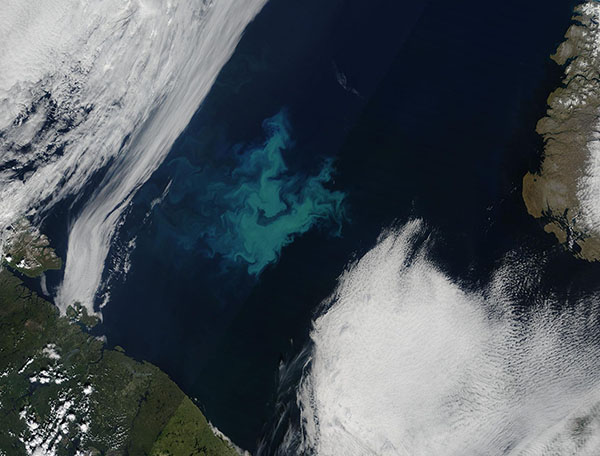Images
August 14, 2024 - Bloom in the Barents Sea
Tweet
When summer arrives at high northern latitudes, peripheral seas to the Arctic Ocean lose some of their ice cover and bask in long daylight hours. That’s when phytoplankton—microscopic plant-like organisms that often float near the ocean surface—can bloom across large swaths of these waters.
Summer conditions in the Barents Sea, a shallow shelf sea off the northern coasts of Norway and Russia, are conducive to these expansive, visually stunning blooms. In late July and early August 2024, communities of phytoplankton grew and drifted at the whims of winds and currents in the Barents Sea. The Moderate Resolution Imaging Spectroradiometer (MODIS) on NASA’s Terra satellite acquired this true-color image on August 13.
Many phytoplankton species live in these cool waters, but the milky blue color in this scene suggests that the bloom contains coccolithophores, a type of plankton plated with white calcium carbonate. The coccolithophore species Emiliana huxleyi is a common constituent of Barents Sea blooms at this time of year, as it thrives when waters become warmer and more stratified. In the spring and early summer, when waters are better-mixed and higher in nutrients, blooms are typically composed of diatoms. This microscopic form of algae with silica shells and ample chlorophyll appears green in true-color satellite images.
Image Facts
Satellite:
Terra
Date Acquired: 8/13/2024
Resolutions:
1km (197.6 KB), 500m (539 KB), 250m ( B)
Bands Used: 1,4,3
Image Credit:
MODIS Land Rapid Response Team, NASA GSFC
Tweet
When summer arrives at high northern latitudes, peripheral seas to the Arctic Ocean lose some of their ice cover and bask in long daylight hours. That’s when phytoplankton—microscopic plant-like organisms that often float near the ocean surface—can bloom across large swaths of these waters.
Summer conditions in the Barents Sea, a shallow shelf sea off the northern coasts of Norway and Russia, are conducive to these expansive, visually stunning blooms. In late July and early August 2024, communities of phytoplankton grew and drifted at the whims of winds and currents in the Barents Sea. The Moderate Resolution Imaging Spectroradiometer (MODIS) on NASA’s Terra satellite acquired this true-color image on August 13.
Many phytoplankton species live in these cool waters, but the milky blue color in this scene suggests that the bloom contains coccolithophores, a type of plankton plated with white calcium carbonate. The coccolithophore species Emiliana huxleyi is a common constituent of Barents Sea blooms at this time of year, as it thrives when waters become warmer and more stratified. In the spring and early summer, when waters are better-mixed and higher in nutrients, blooms are typically composed of diatoms. This microscopic form of algae with silica shells and ample chlorophyll appears green in true-color satellite images.
Image Facts
Satellite:
Terra
Date Acquired: 8/13/2024
Resolutions:
1km (197.6 KB), 500m (539 KB), 250m ( B)
Bands Used: 1,4,3
Image Credit:
MODIS Land Rapid Response Team, NASA GSFC




